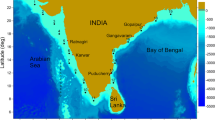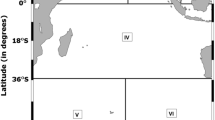Abstract
A proper knowledge and understanding of wind-wave characteristics and its variability on basin, regional and local scales have profound importance and practical applications in marine related activities, ocean engineering, and coastal zone management. The present study deals with the comparison of synoptic annual trends derived from space borne measurements (1992–2016), ERA-5 (1992–2018), and NCEP WWIII global run (1997–2018), monthly and seasonal wave climatology, characteristics of the annual cycle in regional basins and monthly trends of wind-wave climate on a pentad scale. Evaluation of wind-wave characteristics was performed for sub-divided domains of the IO. Further, the wave heights were segregated into percentile ranks (from 99th to 10th) by which a detailed analysis was carried out at the regional scale. Analysis of monthly and seasonal climatology signifies that the highest wave activity is observed in the extra tropical South Indian Ocean (ETSI) and the least in the Bay of Bengal. Higher percentile waves (99th, 95th, and 90th) in the ETSI are observed to be active for more than 6 months in a year. In the Arabian Sea, the maximum occurrence of 99th percentile waves (about 65%) is prominent during the month of July. An apparent pentad variation has been identified in the ETSI from 1997 to 2016 whereas, decadal variability in the north Indian Ocean (NIO) and Tropical South Indian Ocean for the lower percentile significant wave heights (25th and 10th percentiles). During the period 2007–2011, the IO experienced a considerable decreasing wave activity in all the sectors. The observed trends in annual maximum significant wave height for the ETSI and the annual mean significant wave height for the NIO are found increasing at a rate of 3.3 cm/year and 0.27 cm/year, respectively.












Similar content being viewed by others
References
Aboobacker VM, Shanas PR (2018a) The climatology of shamals in the Arabian Sea—Part 1: surface winds. Int J Climatol. https://doi.org/10.1002/joc.5711
Aboobacker VM, Shanas PR (2018b) The climatology of shamals in the Arabian Sea—Part 2: surface waves. Int J Climatol. https://doi.org/10.1002/joc.5677
Aboobacker VM, Vethamony P, Rashmi R (2011) “Shamal” swells in the Arabian Sea and their influence along the west coast of India. Geophys Res Lett. https://doi.org/10.1029/2010GL045736
Alves JHGM (2006) Numerical modeling of ocean swell contributions to the global wind-wave climate. Ocean Model. https://doi.org/10.1016/j.ocemod.2004.11.007
Amrutha MM, Sanil Kumar V, Sandhya KG, Balakrishnan Nair TM, Rathod JL (2016) Wave hindcast studies using SWAN nested in WAVEWATCH III—comparison with measured nearshore buoy data off Karwar, eastern Arabian Sea. Ocean Eng. https://doi.org/10.1016/j.oceaneng.2016.04.032
Anoop TR, Sanil Kumar V, Shanas PR, Johnson G (2015) Surface wave climatology and its variability in the north Indian Ocean Based on ERA-interim reanalysis. J Atmos Ocean Technol. https://doi.org/10.1175/JTECH-D-14-00212.1
Anoop TR, Sanil Kumar V, Shanas PR, Glejin J, Amrutha MM (2016) Indian Ocean Dipole modulated wave climate of eastern Arabian Sea. Ocean Sci 12:369–378
Anoop TR, Shanas PR, Aboobacker VM, Sanil Kumar V, Sheela Nair L, Prasad R, Reji S (2020) On the generation and propagation of Makran swells in the Arabian Sea. Int J Climatol 40(1):585–593. https://doi.org/10.1002/joc.6192
Arora K, Dash P (2019) The Indian ocean dipole: a missing link between El Niño Modokiand tropical cyclone intensity in the North Indian ocean. Climate 7:3. https://doi.org/10.3390/cli7030038
Bhaskaran PK (2014) Wind-wave climate projections for the Indian Ocean from satellite observations. J Mar Sci Res Dev. https://doi.org/10.4172/2155-9910.s11-005
Bhaskaran PK (2019) Challenges and future directions in ocean wave modeling—a review. J Extreme Events. https://doi.org/10.1142/s2345737619500040
Cavaleri L (2000) The oceanographic tower Acqua Alta—activity and prediction of sea states at Venice. Coast Eng 39:29–70. https://doi.org/10.1016/S0378-3839(99)00053-8
Cavaleri L, Bertotti L (2004) Accuracy of the modelled wind and wave fields in enclosed seas. Tellus A 56:167–175. https://doi.org/10.1111/j.1600-0870.2004.00042.x
Cavaleri L, Bertotti L, Buizza R, Buzzi A, Masato V, Umgiesser G, Zampieri M (2010) Predictability of extreme meteo-oceanographic events in the Adriatic Sea. Q J R Meteorol Soc 136:400–413. https://doi.org/10.1002/qj.567
Chandramohan P, Kumar V, Nayak B (1990) Wave statistics around the Indian coast based on ship observed data. Indian J Mar Sci 20:87–92
Galanis G, Kallos G, Dodson CTJ, Chu PC, Kuo Y-H (2012) Wave height characteristics in the north Atlantic ocean: a new approach based on statistical and geometrical techniques. Stoch Environ Res Risk Assess. https://doi.org/10.1007/s00477-011-0540-2
Gowthaman R, Sanil Kumar V, Dwarakish GS, Mohan SS, Singh J, Ashok Kumar K (2013) Waves in Gulf of Mannar and Palk Bay around Dhanushkodi, Tamil Nadu, India. Curr Sci 104(10):1431–1435
Gupta N, Bhaskaran PK, Dash MK (2015) Recent trends in wind-wave climate for the Indian Ocean. Curr Sci 108(12):2191–2201
Gupta N, Bhaskaran PK, Dash MK (2017) Dipole behaviour in maximum significant wave height over the Southern Indian Ocean. Int J Climatol. https://doi.org/10.1002/joc.5133
Hersbach H, Dick L (2016) ERA5 reanalysis is in production. ECMWF Newsl
Hoffmann L et al (2019) From ERA-interim to ERA5: the considerable impact of ECMWF’s next-generation reanalysis on Lagrangian transport simulations. Atmos Chem Phys. https://doi.org/10.5194/acp-19-3097-2019
Komen GJ, Cavaleri L, Donelan M, Hasselmann K, Hasselmann S, Janssen PAEM (1994) Dynamics and modelling of ocean waves. Cambridge University Press, Cambridge, p 532
Kumar VS, Naseef TM (2015) Performance of ERA-interim wave data in the nearshore waters around India. J Atmos Ocean Technol. https://doi.org/10.1175/JTECH-D-14-00153.1
Kumar ED, Sannasiraj SA, Sundar V, Polnikov VG (2013) Wind-wave characteristics and climate variability in the Indian Ocean Region using altimeter data. Mar Geodesy. https://doi.org/10.1080/01490419.2013.771718
Kumar P, Min S-K, Weller E, Lee H, Wang XL (2016) Influence of climate variability on extreme ocean surface wave heights assessed from ERA-interim and ERA-20C. J Clim. https://doi.org/10.1175/JCLI-D-15-0580.1
Kumar P, Kaur S, Weller E, Min S-K (2019) Influence of natural climate variability on the extreme ocean surface wave heights over the Indian Ocean. J Geophys Res Ocean 124(8):6176–6199
Kurian NP, Rajith K, Shahul Hameed TS, Sheela Nair L, Ramana Murthy MV, Arjun S, Shamji VR (2009) Wind waves and sediment transport regime off the south-central Kerala coast, India. Nat Hazards. https://doi.org/10.1007/s11069-008-9318-3
Lin G, Shao LT, Zheng CW, Chen XB, Zeng LF, Liu ZH, Li RB, Shi WL (2017) Assessment of wave energy in the South China sea based on GIS technology. Adv Meteorol. https://doi.org/10.1155/2017/1372578
Mahmood S, Davie J, Jermey P, Renshaw R, George JP, Rajagopal EN, Indira Rani S (2018) Indian monsoon data assimilation and analysis regional reanalysis: configuration and performance. Atmos Sci Lett. https://doi.org/10.1002/asl.808
Moorthi S, Pan H-L, Caplan P (2001) Changes to the 2001 NCEP operational MRF/AVN global analysis/forecast system. NWS Tech Procedures Bull 484:20
Muhammed Naseef T, Sanil Kumar V (2019) Climatology and trends of the Indian Ocean surface waves based on 39-year long ERA5 reanalysis data. Int J Climatol. https://doi.org/10.1002/joc.6251
Nayak S, Bhaskaran PK, Venkatesan R, Dasgupta S (2013) Modulation of local wind-waves at Kalpakkam from remote forcing effects of Southern Ocean swells. Ocean Eng. https://doi.org/10.1016/j.oceaneng.2013.02.010
Parsons MJ, Crosby AR, Orelup L, Ferguson M, Cox AT (2018) Evaluation of ERA5 reanalysis wind forcing for use in ocean response modeling. Waves in shallow environments (WISE) 2018, April 22–26, 2018, Tel Aviv University, Tel Aviv, Israel. https://www.oceanweather.com/about/papers/index.html
Patra A, Bhaskaran PK (2016) Trends in wind-wave climate over the head Bay of Bengal region. Int J Climatol. https://doi.org/10.1002/joc.4627
Patra A, Bhaskaran PK (2017) Temporal variability in wind-wave climate and its validation with ESSO-NIOT wave atlas for the head Bay of Bengal. Clim Dyn. https://doi.org/10.1007/s00382-016-3385-z
Pomaro A, Cavaleri L, Papa A, Lionello P (2018) Data descriptor: 39 years of directional wave recorded data and relative problems, climatological implications and use. Sci Data. https://doi.org/10.1038/sdata.2018.139
Queffeulou P (2003) Long-term quality status of wave height and wind speed measurements from satellite altimeters. In: Proceedings of the international offshore and polar engineering conference
Queffeulou P (2004) Long-term validation of wave height measurements from altimeters. Mar Geodesy. https://doi.org/10.1080/01490410490883478
Remya PG, Vishnu S, Praveen Kumar B, Balakrishnan Nair TM, Rohith B (2016) Teleconnection between the North Indian Ocean high swell events and meteorological conditions over the Southern Indian Ocean. J Geophys Res Oceans. https://doi.org/10.1002/2016jc011723
Schott FA, McCreary JP (2001) The monsoon circulation of the Indian Ocean. Prog Oceanogr. https://doi.org/10.1016/S0079-6611(01)00083-0
Semedo A, Suselj K, Rutgersson A, Sterl A (2011) A global view on the wind sea and swell climate and variability from ERA-40. J Clim. https://doi.org/10.1175/2010JCLI3718.1
Shanas PR, Kumar VS (2015) Trends in surface wind speed and significant wave height as revealed by ERA-Interim wind wave hindcast in the Central Bay of Bengal. Int J Climatol. https://doi.org/10.1002/joc.4164
Shanas PR, Sanil Kumar V (2014a) Comparison of ERA-interim waves with buoy data in the eastern Arabian sea during high waves. Indian J Geo-Mar Sci 43(7):1343–1346
Shanas PR, Sanil Kumar V (2014b) Temporal variations in the wind and wave climate at a location in the eastern Arabian Sea based on ERA-Interim reanalysis data. Nat Hazards Earth Syst Sci. https://doi.org/10.5194/nhess-14-1371-2014
Shanas PR, Aboobacker VM, Albarakati AMA, Zubier KM (2017) Climate driven variability of wind-waves in the Red Sea. Ocean Model 119:105–117
Slingo J, Spencer H, Koskins B, Berrisford P, Black E (2005) The meteorology of the Western Indian Ocean, and the influence of the East African Highlands. Philos Trans R Soc A Math Phys Eng Sci. https://doi.org/10.1098/rsta.2004.1473
Stopa JE, Cheung KF (2014a) Intercomparison of wind and wave data from the ECMWF reanalysis interim and the NCEP climate forecast system reanalysis. Ocean Model. https://doi.org/10.1016/j.ocemod.2013.12.006
Stopa JE, Cheung KF (2014b) Periodicity and patterns of ocean wind and wave climate. J Geophys Res Ocean. https://doi.org/10.1002/2013jc009729
Stopa JE, Ardhuin F, Stutzmann E, Lecocq T (2019) Sea state trends and variability: consistency between models, altimeters, buoys, and seismic data (1979–2016). J Geophys Res Ocean. https://doi.org/10.1029/2018JC014607
Stow CA, Jolliff J, McGillicuddy DJ Jr, Doney SC, Icarus Allen J, Friedrichs MAM, Rose KA, Wallhead P (2009) Skill assessment for coupled biological/physical models of marine systems. J Mar Syst 76(1–2):4–15. https://doi.org/10.1016/j.jmarsys.2008.03.011
Swain J, Umesh P, Balchand A (2019) WAM and WAVEWATCH-III intercomparison studies in the North Indian Ocean using Oceansat-2 Scatterometer winds. J Ocean Clim Sci Technol Impacts. https://doi.org/10.1177/2516019219866569
Tolman HL (1991) A third-generation model for wind waves on slowly varying, unsteady, and inhomogeneous depths and currents. J Phys Oceanogr. https://doi.org/10.1175/1520-0485(1991)021%3c0782:atgmfw%3e2.0.co;2
Tolman HL (2009) User manual and system documentation of WAVEWATCH-IIITM version 3.14. Technical note. https://doi.org/10.3390/ijerph2006030011
van Sebille E, Sprintall J, Schwarzkopf FU, Sen Gupta A, Santoso A, England MH, Biastoch A, Boning CW (2014) Pacific-to-Indian ocean connectivity: Tasman leakage, Indonesian Throughflow, and the role of ENSO. J Geophys Res Oceans. https://doi.org/10.1002/2013jc009525
Vethamony P, Rao LVG, Kumar R, Sarkar A, Mohan M, Sudheesh K, Karthikeyan SB (2000) Wave climatology of the Indian Ocean derived from altimetry and wave model. In: Proceedings of PORSEC, Goa, India, pp 301–304
Vinoth J, Young IR (2011) Global estimates of extreme wind speed and wave height. J Clim 24:1647–1665
Young IR, Ribal A (2019) Multiplatform evaluation of global trends in wind speed and wave height. Science 364(6440):548–552. https://doi.org/10.1126/science.aav9527
Young IR, Zieger S, Babanin AV (2011) Global trends in wind speed and wave height. Science. https://doi.org/10.1126/science.1197219
Young IR, Vinoth J, Zieger S, Babanin AV (2012) Investigation of trends in extreme value wave height and wind speed. J Geophys Res Oceans. https://doi.org/10.1029/2011jc007753
Zheng CW, Pan J, Li CY (2016a) Global oceanic wind speed trends. Ocean Coast Manag. https://doi.org/10.1016/j.ocecoaman.2016.05.001
Zheng K, Sun J, Guan C, Shao W (2016b) Analysis of the global swell and wind sea energy distribution using WAVEWATCH III. Adv Meteorol. https://doi.org/10.1155/2016/8419580
Zheng CW, Li CY, Pan J (2018) Propagation route and speed of Swell in the Indian Ocean. J Geophys Res Oceans. https://doi.org/10.1002/2016jc012585
Acknowledgements
The authors sincerely thank MHRD, Government of India for the financial support. This study was conducted for the DST Centre of Excellence (CoE) in Climate Change studies established at IIT Kharagpur as a part of the ongoing project ‘Wind-Waves and Extreme Water Level Climate Projections for East Coast of India’. The authors also acknowledge the working group that provided the space borne satellite data, ERA-5 and NCEP WWIII global model runs for carrying out this study.
Author information
Authors and Affiliations
Corresponding author
Additional information
Publisher's Note
Springer Nature remains neutral with regard to jurisdictional claims in published maps and institutional affiliations.
Rights and permissions
About this article
Cite this article
Sreelakshmi, S., Bhaskaran, P.K. Regional wise characteristic study of significant wave height for the Indian Ocean. Clim Dyn 54, 3405–3423 (2020). https://doi.org/10.1007/s00382-020-05186-6
Received:
Accepted:
Published:
Issue Date:
DOI: https://doi.org/10.1007/s00382-020-05186-6




